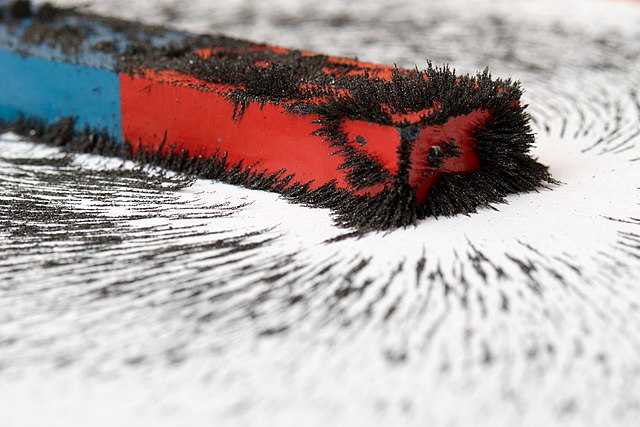Paramagnetism is a form of magnetism whereby some materials are weakly attracted by an externally applied magnetic field, and form internal, induced magnetic fields in the direction of the applied magnetic field. In contrast with this behavior, diamagnetic materials are repelled by magnetic fields and form induced magnetic fields in the direction opposite to that of the applied magnetic field. Paramagnetic materials include most chemical elements and some compounds; they have a relative magnetic permeability slightly greater than 1 and hence are attracted to magnetic fields. The magnetic moment induced by the applied field is linear in the field strength and rather weak. It typically requires a sensitive analytical balance to detect the effect and modern measurements on paramagnetic materials are often conducted with a SQUID magnetometer.
Liquid oxygen (blue) can be suspended between the poles of a strong magnet as a result of its paramagnetism.
In a metal, the application of an external magnetic field increases the density of electrons with spins antiparallel with the field and lowers the density of the electrons with opposite spin. Note: The arrows in this picture indicate spin direction, not magnetic moment.
Idealized Curie–Weiss behavior; N.B. TC=θ, but TN is not θ. Paramagnetic regimes are denoted by solid lines. Close to TN or TC the behavior usually deviates from ideal.
Magnetism is the class of physical attributes that occur through a magnetic field, which allows objects to attract or repel each other. Because both electric currents and magnetic moments of elementary particles give rise to a magnetic field, magnetism is one of two aspects of electromagnetism.
The shape of a bar magnet's magnetic field is revealed by the orientation of iron filings sprinkled on the table around it.
An illustration from Gilbert's 1600 De Magnete showing one of the earliest methods of making a magnet. A blacksmith holds a piece of red-hot iron in a north–south direction and hammers it as it cools. The magnetic field of the Earth aligns the domains, leaving the iron a weak magnet.
Drawing of a medical treatment using magnetic brushes. Charles Jacque 1843, France.
A live frog levitates inside a 32 mm diameter vertical bore of a Bitter solenoid in a very strong magnetic field—about 16 teslas







